North American Soccer League (1968–1984) facts for kids
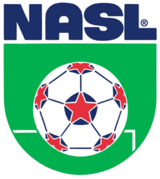 |
|
| Founded | December 7, 1967 |
|---|---|
| Folded | March 28, 1985 |
| Country | United States |
| Other club(s) from | Canada |
| Confederation | CONCACAF |
| Number of teams | 24 |
| Level on pyramid | 1 |
| Promotion to | None |
| Relegation to | None |
| Last champions | Chicago Sting (1984) |
| Most championships | New York Cosmos (5 titles) |
The North American Soccer League (NASL) was a major professional soccer league in the United States and Canada. It ran from 1968 to 1984. The NASL was the first soccer league to become popular across the United States. Its championship game was called the Soccer Bowl.
The league helped soccer grow in the U.S. It laid the groundwork for the country to host the 1994 FIFA World Cup. It also helped lead to the creation of Major League Soccer (MLS) in 1996.
Before the NASL, two separate soccer leagues existed in 1967. They were the United Soccer Association (USA) and the National Professional Soccer League (NPSL). These two leagues joined together in December 1967 to form the NASL.
The NASL was most popular in the late 1970s. From 1977 to 1983, over 13,000 fans watched each game on average. Games were even shown on TV from 1975 to 1980.
The most famous team was the New York Cosmos. They signed some of the world's best players like Pelé and Franz Beckenbauer. The Cosmos often had over 28,000 fans per game. Sometimes, more than 40,000 people came to watch them play. Other well-known players in the league included Johan Cruyff and George Best.
However, the league grew too fast. An economic downturn in the early 1980s also hurt it. Problems with the players' union also played a part. These issues led to the NASL closing down after the 1984 season.
The NASL also had indoor soccer tournaments. These were held in various years, and a full indoor season ran from 1979 to 1984.
Contents
History
How the League Started
Many people in North America watched the 1966 FIFA World Cup on TV. This made sports investors think soccer could be popular in the U.S. and Canada. In 1967, two different professional soccer leagues began. One was the United Soccer Association (USA), which brought European and South American teams to play. The other was the National Professional Soccer League (NPSL).
The two leagues merged on December 7, 1967. This created the North American Soccer League (NASL). The first NASL season in 1968 had 17 teams. Most players were from other countries, like Brazilian star Vavá.
Even with some success, the league struggled to gain fans. Teams spent a lot on foreign players' salaries and stadium rentals. But few people came to games, so teams lost money. By the end of 1968, most teams folded. Only five teams remained.
To keep the league alive, the NASL invited two teams from a semi-pro league to join. These teams, the Rochester Lancers and the Washington Darts, became very successful. Rochester won the championship in 1970, helping the league survive.
In 1971, three new teams joined. They included the New York Cosmos.
New Rules for Excitement
The NASL changed some rules to make soccer more exciting for American fans.
- The game clock counted down to zero, like in other American sports.
- A special line was added 35 yards from the goal. This changed the offside rule to create more scoring chances. FIFA allowed this rule until 1982.
- If a game ended in a tie, they used a penalty shootout. This was like a hockey penalty shot. Players started at the 35-yard line and had five seconds to score.
- Teams earned points for winning and bonus points for each goal scored (up to three goals). This unique system sometimes meant the team with the most wins didn't win the regular season title.
Growing Interest
In the early 1970s, many NASL players had other jobs. It was almost a semi-professional league.
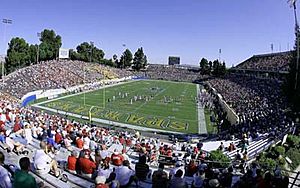
In 1973, Sports Illustrated magazine featured a soccer player on its cover for the first time. It was Philadelphia Atoms goalkeeper Bob Rigby. The Philadelphia Atoms won the NASL championship in their first season. This was a big deal for American sports.
More fans started coming to games. Average attendance grew from 2,930 in 1969 to 7,770 in 1974. The 1974 NASL Championship game was shown live on CBS. This was the first national TV broadcast of a pro soccer game in the U.S. since 1968.
The NASL expanded quickly in 1974 and 1975. Eight new teams joined in 1974, and five more in 1975. This gave the league a presence across the country. By 1975, the NASL had grown from 9 teams to 20.
In 1975, famous international players started joining the league. These included Portuguese star Eusébio.
Pelé and the New York Cosmos
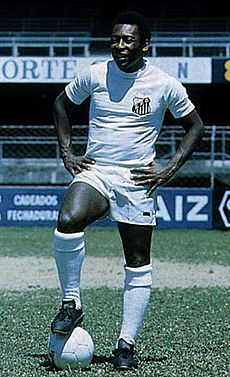
In 1975, the New York Cosmos signed Pelé, one of the greatest soccer players ever. This created a huge buzz and changed soccer in the United States overnight. Pelé's arrival brought a lot of attention to the league. The Cosmos' home game attendance tripled. Other teams also saw bigger crowds when the Cosmos played in their cities.
Pelé's presence also led to more TV coverage. Ten million people watched Pelé's first game on CBS. This was a record for American soccer TV audiences. By 1976, major newspapers started covering the NASL.
The Cosmos became the league's biggest team. They often drew over 40,000 fans per game. This was especially true when older soccer superstars like Pelé and Franz Beckenbauer played for them. Even though these players were past their prime, they were still famous worldwide.
The Soccer Bowl '78 championship game, featuring the Cosmos, sold out Giants Stadium with over 73,000 fans. However, the league's overall average attendance never reached 15,000. Some clubs had less than 5,000 fans per game.
More Stars and Growth
The Los Angeles Aztecs signed George Best, a star from Manchester United, in 1976. Later, in 1979, Los Angeles signed Johan Cruyff, another Dutch superstar. Cruyff instantly doubled the team's attendance and won the league's MVP award.
The Minnesota Kicks also became very popular. They drew over 23,000 fans per game from 1976 to 1979.
Despite this apparent success, many teams were struggling financially. A committee suggested limiting expansion to strengthen existing teams. But the NASL ignored this advice. They added six new teams in 1978, bringing the total to 24.
NASL teams started spending a lot of money on player salaries. They tried to sign famous older players to match the Cosmos' success. This drove up costs, and many owners lost millions of dollars.
The league also tried to increase the number of American and Canadian players. They started a college draft in 1972. Rules were put in place to require more North American players on the field. By 1980, teams had to start at least three U.S. or Canadian players.
By the end of the 1970s, the NASL seemed to be doing well. Attendance increased by 8% in 1979. ABC televised several matches. The league seemed stable with no planned expansions or team moves in 1980.
Financial Troubles and Decline
| Season | Teams | Games | Attendance | Network TV (games) |
|---|---|---|---|---|
| 1968 | 17 | 32 | 4,699 | CBS |
| 1969 | 5 | 16 | 2,930 | None |
| 1970 | 6 | 24 | 3,163 | |
| 1971 | 8 | 4,154 | ||
| 1972 | 14 | 4,780 | ||
| 1973 | 9 | 19 | 5,954 | |
| 1974 | 15 | 20 | 7,770 | CBS (1) |
| 1975 | 20 | 22 | 7,642 | CBS (2) |
| 1976 | 10,295 | CBS (2) | ||
| 1977 | 18 | 26 | 13,558 | TVS (7) |
| 1978 | 24 | 30 | 13,084 | TVS (6) |
| 1979 | 14,201 | ABC (9) | ||
| 1980 | 32 | 14,440 | ABC (8) | |
| 1981 | 21 | 14,084 | ABC (1) | |
| 1982 | 14 | 13,155 | None | |
| 1983 | 12 | 30 | 13,258 | |
| 1984 | 9 | 24 | 10,759 | |
| TV column includes only network TV. It does not include cable (ESPN, USA) or pay-per-view (SportsVision). |
||||
By 1980, the NASL faced serious problems. The league had expanded too much, and the U.S. economy was in a recession. Also, there were disagreements with the players' union.
Owners were spending too much money on player salaries. On average, NASL teams spent over 70% of their budget on player salaries. In comparison, NFL teams spent about 40%. Teams like the Cosmos, owned by large companies, could afford this. But other teams could not keep up. Owners spent millions on older stars, hoping for success, but often lost money.
Another challenge came from the Major Indoor Soccer League (MISL). The MISL started in 1978 and quickly grew popular. This led to a bidding war for players, making NASL's financial problems worse. The NASL even started its own indoor league to compete.
In 1980, the league lost about $30 million in total. Every team was losing money. For example, the Washington Diplomats folded in 1980 after losing millions.
The 1981 season was even worse. The league again lost $30 million. Five teams folded at the end of the season. Two more teams closed down later. The NASL shrank from 21 teams to 14.
Many new owners joined the league when it seemed popular. But they left quickly when teams started losing money. Over-expansion without careful checks on owners was a big reason the league failed.
The End of the NASL
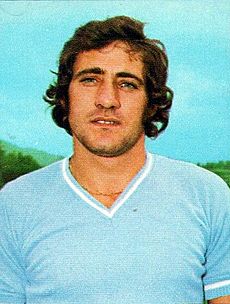
As the league declined, it tried to make changes. Phil Woosnam, who had been the NASL Commissioner since 1969, was removed in 1982. The NASL also tried to bring the 1986 World Cup to the U.S. But FIFA chose Mexico instead.
In 1984, the league agreed to a salary cap for players. This meant teams would spend less on salaries. It also reduced the number of players on each team.
The league played its last season in 1984 with only nine teams. On March 28, 1985, the NASL stopped operations. Only two teams were still interested in playing. The league planned to restart in 1986, but it never did.
Some of the last NASL teams joined the Major Indoor Soccer League. The Tampa Bay Rowdies were the last NASL team to play outdoor soccer, lasting until 1994. The San Diego Sockers played indoor soccer until 1996.
What the NASL Left Behind
Even though the NASL failed, it was important for soccer in North America. It introduced the sport to many people for the first time on a large scale. Soccer became one of the most popular sports for young people in America.
The NASL also taught lessons for Major League Soccer (MLS). MLS learned to be careful with money and avoid overspending. Some NASL-style rules are still used in American college and high school soccer.
Many former NASL players went on to play in the 1986 FIFA World Cup for Canada. The U.S. national team also had some former NASL players in later World Cups.
Several NASL team names are still used today by new soccer teams. For example, the Portland Timbers, San Jose Earthquakes, Seattle Sounders FC, and Vancouver Whitecaps FC are all MLS teams. Other names like New York Cosmos and Tampa Bay Rowdies are used in other leagues. Some old rivalries, like the Cascadia Cup, also started in the NASL.
NASL Indoor Soccer
| Year | Participation | Games played |
|---|---|---|
| 1971 | 4 of 8 teams | 4 games |
| 1975 | 16 of 20 teams | 2-4 games |
| 1976 | 12 of 20 teams | |
| 1977 | — | — |
| 1978 | 4 of 24 teams | 4 games |
| 1979 | 4 of 24 teams | 4 games |
| 1979–80 | 10 of 24 teams | 12 games |
| 1980–81 | 19 of 21 teams | 18 games |
| 1981–82 | 13 of 14 teams | |
| 1983 | 4 of 12 teams | 8 games |
| 1983–84 | 7 of 9 teams | 32 games |
The NASL also had indoor soccer. They held their first indoor tournament in 1971. After some smaller tournaments, the league started a full indoor season in 1979–80. Ten teams played a 12-game schedule.
The indoor league grew in 1980–81 with 19 teams. But it shrank again in later years. The NASL indoor season returned for 1983–84 with seven teams playing a 32-game schedule.
NASL Champions
By Year
| Year | Winner (number of titles) | Runners-up | Top Team in Regular Season (points) | Top scorer (points) | Winning Coach |
|---|---|---|---|---|---|
| 1968 | Atlanta Chiefs (1) | San Diego Toros | San Diego Toros (186 points)* | ||
| 1969 | Kansas City Spurs (1) | Atlanta Chiefs | Kansas City Spurs (110 points)* | ||
| 1970 | Rochester Lancers (1) | Washington Darts | Washington Darts (137 points) | ||
| 1971 | Dallas Tornado (1) | Atlanta Chiefs | Rochester Lancers (141 points) | ||
| 1972 | New York Cosmos (1) | St. Louis Stars | New York Cosmos (77 points) | ||
| 1973 | Philadelphia Atoms (1) | Dallas Tornado | Dallas Tornado (111 points) | ||
| 1974 | Los Angeles Aztecs (1) | Miami Toros | Los Angeles Aztecs (110 points) | ||
| 1975 | Tampa Bay Rowdies (1) | Portland Timbers | Portland Timbers (138 points) | ||
| 1976 | Toronto Metros-Croatia (1) | Minnesota Kicks | Tampa Bay Rowdies (154 points) | ||
| 1977 | New York Cosmos (2)# | Seattle Sounders | Fort Lauderdale Strikers (161 points) | ||
| 1978 | New York Cosmos (3)# | Tampa Bay Rowdies | Cosmos (212 points) | ||
| 1979 | Vancouver Whitecaps (1) | Tampa Bay Rowdies | New York Cosmos (216 points) | ||
| 1980 | New York Cosmos (4) | Fort Lauderdale Strikers | New York Cosmos (213 points)* | ||
| 1981 | Chicago Sting (1) | New York Cosmos | New York Cosmos (200 points) | ||
| 1982 | New York Cosmos (5) | Seattle Sounders | New York Cosmos (203 points) | ||
| 1983 | Tulsa Roughnecks (1) | Toronto Blizzard | New York Cosmos (194 points)* | ||
| 1984 | Chicago Sting (2) | Toronto Blizzard | Chicago Sting (120 points)* |
* Due to the NASL's nontraditional points system, in 1968, 1969, 1980, 1983 & 1984 the team with the best win–loss record did not win the regular season.
# The New York Cosmos dropped "New York" from its name for the 1977 and 1978 seasons, then returned to the full name.
By Club
| Club | Winner | Runner-up | Seasons Won | Seasons Runner-up |
|---|---|---|---|---|
| New York Cosmos | 5 | 1 | 1972, 1977, 1978, 1980, 1982 | 1981 |
| Chicago Sting | 2 | 0 | 1981, 1984 | – |
| Atlanta Chiefs | 1 | 2 | 1968 | 1969, 1971 |
| Tampa Bay Rowdies | 1 | 2 | 1975 | 1978, 1979 |
| Toronto Metros/Blizzard | 1 | 2 | 1976 | 1983, 1984 |
| Dallas Tornado | 1 | 1 | 1971 | 1973 |
| Kansas City Spurs | 1 | 0 | 1969 | – |
| Rochester Lancers | 1 | 0 | 1970 | – |
| Philadelphia Atoms | 1 | 0 | 1973 | – |
| Los Angeles Aztecs | 1 | 0 | 1974 | – |
| Vancouver Whitecaps | 1 | 0 | 1979 | – |
| Tulsa Roughnecks | 1 | 0 | 1983 | – |
| Seattle Sounders | 0 | 2 | – | 1977, 1982 |
| San Diego Toros | 0 | 1 | – | 1968 |
| Washington Darts | 0 | 1 | – | 1970 |
| St. Louis Stars | 0 | 1 | – | 1972 |
| Miami Toros | 0 | 1 | – | 1974 |
| Portland Timbers | 0 | 1 | – | 1975 |
| Minnesota Kicks | 0 | 1 | – | 1976 |
| Fort Lauderdale Strikers | 0 | 1 | – | 1980 |
# The New York Cosmos dropped "New York" from its name for the 1977 and 1978 seasons, then returned to the full name.
NASL Indoor Champions
By Year
| Year | Winner (number of titles) | Runners-up | Top Team in Regular Season | Top scorer | Winning Coach |
|---|---|---|---|---|---|
| 1971 | Dallas Tornado (1) | Rochester Lancers | Dallas Tornado 2–0 *(tournament only) | ||
| 1975 | San Jose Earthquakes (1) | Tampa Bay Rowdies | San Jose Earthquakes 4–0 *(tournament only) | ||
| 1976 | Tampa Bay Rowdies (1) | Rochester Lancers | Tampa Bay Rowdies 4–0 *(tournament only) | ||
| 1978 | Tulsa Roughnecks (1) | Minnesota Kicks | Tulsa Roughnecks 2–0 *(tournament only) | ||
| 1979 | Dallas Tornado (2) | Tampa Bay Rowdies | Dallas Tornado 2–0 *(tournament only) | ||
| 1979–80 | Tampa Bay Rowdies (2) | Memphis Rogues | Atlanta Chiefs 10–2 | ||
| 1980–81 | Edmonton Drillers (1) | Chicago Sting | Chicago Sting 13–5 | ||
| 1981–82 | San Diego Sockers (1) | Tampa Bay Rowdies | Edmonton Drillers 13–5 | ||
| 1983 | Tampa Bay Rowdies (3) | Montreal Manic | Montreal Manic 4–2 *(double round-robin stage) | ||
| 1983–84 | San Diego Sockers (2) | New York Cosmos | San Diego Sockers 21–11 |
By Club
| Club | Winner | Runner-up | Seasons Won | Seasons Runner-up |
|---|---|---|---|---|
| Tampa Bay Rowdies | 3 | 3 | 1976, 1979–80, 1983 | 1975, 1979, 1981–82 |
| Dallas Tornado | 2 | 0 | 1971, 1979 | – |
| San Diego Sockers | 2 | 0 | 1981–82, 1983–84 | – |
| San Jose Earthquakes | 1 | 0 | 1975 | – |
| Tulsa Roughnecks | 1 | 0 | 1978 | – |
| Edmonton Drillers | 1 | 0 | 1980–81 | – |
| Rochester Lancers | 0 | 2 | – | 1971, 1976 |
| Minnesota Kicks | 0 | 1 | – | 1978 |
| Memphis Rogues | 0 | 1 | – | 1979–80 |
| Chicago Sting | 0 | 1 | – | 1980–81 |
| Montreal Manic | 0 | 1 | – | 1983 |
| New York Cosmos | 0 | 1 | – | 1983–84 |
Commissioners
- 1967: Dick Walsh (USA)
- 1967: Ken Macker (NPSL)
- 1968: Walsh and Macker co-commissioners
- 1969–83: Phil Woosnam – He helped grow the NASL and got TV deals. He also helped create the New York Cosmos. But he also made some bad business choices, like expanding too quickly, which led to teams losing money.
- 1983–84: Howard J. Samuels
- 1984–85: Clive Toye (acting) – He became interim president after Howard J. Samuels passed away. The league stopped operations soon after.
Awards
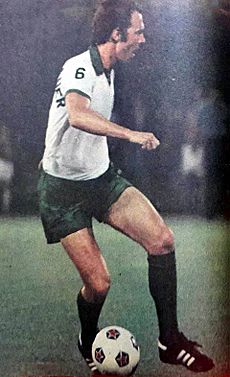
Most Valuable Player, Rookie of the Year, Coach of the Year
| Year | MVP | Rookie | Coach |
|---|---|---|---|
| 1968 | |||
| 1969 | |||
| 1970 | |||
| 1971 | |||
| 1972 | |||
| 1973 | |||
| 1974 | |||
| 1975 | |||
| 1976 | |||
| 1977 | |||
| 1978 | |||
| 1979 | |||
| 1980 | |||
| 1981 | |||
| 1982 | |||
| 1983 | |||
| 1984 |
Famous Players
The NASL brought some of the world's best soccer players to the United States. This started early with players like Vavá in 1968. After the Cosmos signed Pelé in 1975, even more famous players joined.
Many players who won major awards or played in World Cups came to the NASL. For example, 20 players who were chosen for the World Cup Best XI teams between 1966 and 1978 played in the NASL. At one point, the NASL had the captains of the past three World Cup-winning teams: Beckenbauer (1974), Carlos Alberto (1970), and Bobby Moore (1966).
Eight players who won the European Footballer of the Year award between 1965 and 1976 also played in the NASL. These included Eusébio, George Best, Gerd Müller, Johan Cruyff, and Franz Beckenbauer.
Some players became even more famous after leaving the NASL. These included Peter Beardsley and Hugo Sánchez. Only two players, Hugo Sánchez and Roy Wegerle, played in both the NASL and later in MLS.
| Player | Position | NASL years | NASL club(s) | Accolades (pre-NASL) |
|---|---|---|---|---|
| FW | 1975–1977 | New York Cosmos | Three World Cup championships with Brazil in 1958, 1962, 1970; 1973 South American Footballer of the Year |
|
| DF | 1977–1982 | New York Cosmos; California |
Captained Brazil to victory at the 1970 World Cup | |
| DF | 1981 | Fort Lauderdale | South American Footballer of the Year in 1974, 1975, and 1976 | |
| MF | 1978–1980 | Philadelphia; Vancouver |
Set up two Hurst goals at the 1966 World Cup Final; Played at the 1970 World Cup |
|
| GK | 1977–1978 | Fort Lauderdale | GK for England during their 1966 World Cup championship run; Six-time FIFA Goalkeeper of the Year |
|
| FW | 1976 | Seattle | Scored a hat trick for England at the 1966 World Cup Final; 1968 Euro All-Star team |
|
| DF | 1976; 1978 | San Antonio; Seattle |
Captained England to victory at the 1966 World Cup | |
| FW | 1982–1983 | Vancouver Whitecaps | England International | |
| DF | 1977–1980; 1983 | New York Cosmos | Captained West Germany to victory at the 1974 World Cup European Player of the Year 1972 and 1976 FIFA World Cup All-Star team 1966, 1970 and 1974 |
|
| FW | 1979–1981 | Fort Lauderdale | 1970 European Footballer of the Year; Scored 10 goals at the 1970 World Cup; 1974 World Cup winner |
|
| FW | 1983–1984 | Toronto Blizzard | Named to the 1978 World Cup All-Star team; Ranked third on Juventus' career goals scored (#2 at time of retirement) |
|
| MF | 1979–1981 | Los Angeles Aztecs; Washington Diplomats |
Led the Netherlands to the 1974 World Cup final; European Footballer of the Year award in 1971, 1973, and 1974 |
|
| DF | 1980 | Vancouver Whitecaps | Captain of the Netherlands team that reached the 1978 World Cup Final | |
| MF | 1979–1984 | New York Cosmos | Reached World Cup finals with the Netherlands in 1974 and 1978; Named to the 1974 World Cup All-Star team; Won 3 European Cups with Ajax from 1971 to 1973 |
|
| MF | 1980 | Portland | Winner of the 1976 Onze d'Or; Reached World Cup finals with the Netherlands in 1974 and 1978; Second leading scorer at the 1978 World Cup |
|
| DF | 1979–1983 | Los Angeles Aztecs; San Jose Earthquakes |
Reached World Cup finals with the Netherlands in 1974 and 1978; Won 3 European Cups with Ajax from 1971 to 1973 |
|
| MF | 1976–1982 | Los Angeles Aztecs; Fort Lauderdale; San Jose |
1968 European Footballer of the Year | |
| MF | 1980–1983 | New York Cosmos | 1979 Copa América winner with Paraguay; 1985 South American Footballer of the Year |
|
| FW/MF | 1979–1983 | Fort Lauderdale | Named Best Young Player of 1970 World Cup; 1972 South American Footballer of the Year; Scored 5 goals in two different World Cups (1970, 1978) Named to 1978 World Cup All-Star team |
|
| MF | 1981–1984 | San Diego Sockers | Top scorer at the 1972 Olympics; Member of Poland team that finished 3rd at the 1974 World Cup; Won the Bronze Ball as the 3rd best player at the 1974 World Cup |
|
| MF | 1975–1979 | Boston Minutemen; Toronto; Las Vegas |
1965 European Footballer of the Year; 1966 World Cup Golden Boot (top scorer) |
|
| MF | 1975–1979 | Boston; San Jose; Dallas |
1962 European Cup winner with Benfica; Member of Portugal's Magriços team that placed 3rd at 1966 World Cup |
|
| MF | 1979–1983 | Toronto; Vancouver | Scored 255 goals for Leeds United | |
| DF | 1979–1980 | Minnesota | Former world record holder with 115 caps; Played at the 1970, 1974, and 1978 World Cups |
Attendance
Yearly Average Attendance
| Season | Lowest | Low Team | Average | Highest | High Team | 2nd Highest | 2nd Team |
|---|---|---|---|---|---|---|---|
| 1968 | 2,441 | Los Angeles Wolves | 4,699 | 8,510 | Kansas City Spurs | 6,840 | Washington Whips |
| 1969 | 1,601 | Baltimore Bays | 2,930 | 4,273 | Kansas City Spurs | 3,371 | Atlanta Chiefs |
| 1970 | 2,398 | Kansas City Spurs | 3,163 | 4,506 | Rochester Lancers | 3,894 | Washington Darts |
| 1971 | 2,440 | Montreal Olympique | 4,154 | 5,993 | Toronto Metros | 5,871 | Rochester Lancers |
| 1972 | 2,112 | Miami Gatos | 4,780 | 7,773 | St. Louis Stars | 7,173 | Toronto Metros |
| 1973 | 3,317 | Atlanta Apollos | 5,954 | 11,501 | Philadelphia Atoms | 7,474 | Dallas Tornado |
| 1974 | 3,458 | Toronto Metros | 7,770 | 16,584 | San Jose Earthquakes | 13,454 | Seattle Sounders |
| 1975 | 2,641 | Baltimore Comets | 7,930 | 17,927 | San Jose Earthquakes | 16,826 | Seattle Sounders |
| 1976 | 2,571 | Boston Minutemen | 10,295 | 23,828 | Seattle Sounders | 23,121 | Minnesota Kicks |
| 1977 | 3,848 | Connecticut Bicentennials | 13,558 | 34,142 | *Cosmos | 32,775 | Minnesota Kicks |
| 1978 | 4,188 | Chicago Sting | 13,084 | 47,856 | *Cosmos | 30,928 | Minnesota Kicks |
| 1979 | 5,626 | Philadelphia Fury | 14,201 | 46,690 | New York Cosmos | 27,650 | Tampa Bay Rowdies |
| 1980 | 4,465 | Philadelphia Fury | 14,440 | 42,754 | New York Cosmos | 28,435 | Tampa Bay Rowdies |
| 1981 | 4,670 | Dallas Tornado | 14,084 | 34,835 | New York Cosmos | 23,704 | Montreal Manic |
| 1982 | 4,922 | Edmonton Drillers | 13,155 | 28,749 | New York Cosmos | 21,348 | Montreal Manic |
| 1983 | 4,212 | San Diego Sockers | 13,258 | 29,166 | Vancouver Whitecaps | 27,242 | New York Cosmos |
| 1984 | 5,702 | San Diego Sockers | 10,759 | 14,263 | Minnesota Strikers | 13,924 | Vancouver Whitecaps |
*Cosmos dropped "New York" from name for 1977 and 1978 seasons
Single-Game Attendance Records
The New York Cosmos hold most of the top attendance records in NASL history. They had 65 home games with over 40,000 fans at Giants Stadium. The table below shows teams with 40,000+ crowds.
| Team | 40,000+ | Highest Single Attendance | Notes |
|---|---|---|---|
| New York Cosmos | 65 matches | 77,691 vs Fort Lauderdale (1977) | playoff game |
| Tampa Bay Rowdies | 12 matches | 56,389 vs California (1980) | Fourth of July fireworks display after game |
| Minnesota Kicks | 8 matches | 49,572 vs San Jose (1976) | playoff game |
| Seattle Sounders | 6 matches | 58,125 vs New York (1976) | first sporting event in Kingdome |
| Soccer Bowl | 4 matches | 74,901 Cosmos vs Tampa Bay (1978) | played in Giants Stadium |
| Montreal Manic | 4 matches | 58,542 vs Chicago (1981) | playoff game |
| Vancouver Whitecaps | 3 matches | 60,342 vs Seattle (1983) | first sporting event in BC Place |
| Los Angeles Aztecs | 2 matches | 48,483 vs Washington (1980) | Fourth of July fireworks display after game |
| Washington Diplomats | 1 match | 53,351 vs New York (1980) | nationally televised on ABC |
| Minnesota Strikers | 1 match | 52,621 vs Tampa Bay (1984) | Beach Boys concert after game |
| Team America | 1 match | 50,108 vs Fort Lauderdale (1983) | Beach Boys concert after game |
Images for kids
See also
 In Spanish: North American Soccer League para niños
In Spanish: North American Soccer League para niños
- List of American and Canadian soccer champions
- North American Soccer League on television
- Record attendances in United States club soccer
- Soccer Bowl



